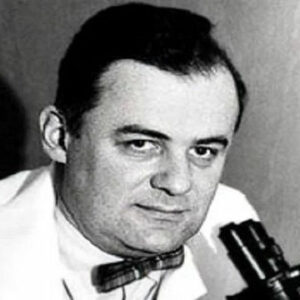Frederick Chapman Robbins was an American paediatrician and virologist who shared the Nobel Prize in Medicine in 1954 with John Franklin Enders and Thomas Huckle Weller. The trio was recognized for their discovery of poliomyelitis viruses’ ability to proliferate in tissue cultures of many sorts. This was a game-changing finding at the time because it allowed scientists to grow the virus in a test tube and develop a vaccine that eventually eradicated the devastating sickness from most of the world’s countries. The groundbreaking effort in isolating and growing the polio virus paid off in a big way. The tissue culture approach that was established assisted in the isolation of an expanding number of infectious disease viruses and has substantial implications for cancer. Apart from his scientific work, Robbins was also an important academic leader. He was President of the Institute of Medicine of the National Academy of Sciences and Professor Emeritus of Case Western Reserve Medical School.
Childhood and Adolescence
Frederick Chapman Robbins was born in Auburn, Alabama, to botanists William J Robbins and Christine née Chapma on August 25, 1916. His father was a plant scientist who rose through the ranks of the New York Botanical Gardens to become the Director.
Robbins was accepted to the University of Missouri after finishing his secondary school. He earned his A.B degree in 1936 and his B.S degree in 1938 there. Robbins went to Harvard Medical School after receiving his B.S. In 1940, he received his diploma.
Career of Frederick
Frederick Chapman Robbins was assigned as a resident physician in bacteriology at The Children’s Hospital Medical Center in Boston, Massachusetts, shortly after graduating from Harvard Medical School. He continued his training there for the next two years.
Robbins enlisted in the United States Army in 1942, after finishing his training at the Children’s Hospital Medical Center. During his army service, Robbins was the Chief of the Fifteenth Medical General Laboratory’s Virus and Rickettsial Disease Section. He served in this capacity in a variety of locations, including the United States, North Africa, and Italy. He worked as a supervisor of the diagnostic virus laboratory while also studying mumps immunology.
Robbins was discharged from the service in 1946. He returned to the Children’s Hospital Medical Center to begin his training, which he completed in January 1948. Robbins had a National Research Council Senior Fellowship in Virus Diseases from 1948 to 1950. At the same time, he was a member of the Harvard Medical School’s Faculty.
In 1948, Robbins worked at The Children’s Hospital Medical Center’s Research Division of Infectious Diseases with Dr. John F. Enders. There was no simple way for scientists to work with viruses in the lab at the time. Instead, they were forced to do experiments on eggs, mice, monkeys, and other animals.
Robbins and his colleagues worked in the lab to generate polio and other viruses in order to develop vaccinations. Robbins, Enders, and Weller were finally able to generate the viruses after much work, utilizing a mixture of human embryonic skin and muscle tissue. Following that, the trio looked into the development of the poliomyelitis virus in tissue culture and how to use it. Dr. Jonas Salk was able to produce polio vaccinations thanks to this achievement.
Robbins relocated to Cleveland, Ohio, in 1952. Professor of Paediatrics at Case Western Reserve University School of Medicine, he was hired there. He held the position of Professor of Contagious Diseases at Cleveland City Hospital at the same time (today known as MetroHealth Medical Center). Robins was the Dean of the Case Western Reserve University School of Medicine from 1966 to 1969. He held this office from 1980 to 1980.
In 1980, Robbins was elected President of the Institute of Medicine of the National Academy of Sciences. Robbins was credited for laying the groundwork for projects that contributed to national policy on vaccine research, vaccination safety, and workforce challenges while at the institution. He also created projects to draw attention to AIDS-related public policy.
Robbins resigned as President in 1985 to return to Case Western Reserve University as Dean Emeritus and distinguished University professor Emeritus. He remained at the medical school until 2003, when he died.
Major Projects of Frederick
At the close of the 1940s decade, Robbins made his most major contribution. He effectively solved the challenge of replicating viruses in laboratory suspensions of actively metabolizing cells in nutritional solutions, working with John Franklin Enders and Thomas Weller. Robbins and his colleagues assisted in the growth of polio and other viruses in the laboratory in order to produce vaccinations.
They successfully demonstrated that the polio virus existed in extraneural tissue using combinations of human embryonic skin and muscle tissue suspended in cell cultures. The discovery of the ability of poliomyelitis viruses to proliferate in cultures of diverse types of tissue earned the trio the Nobel Prize in Physiology or Medicine.
Achievements & Awards
Robbins was awarded the Bronze Star for Distinguished Service in World War II in 1945. Robbins was awarded the Nobel Prize in Physiology or Medicine in 1954, along with John Franklin Enders and Thomas Weller, for their discovery of the ability of poliomyelitis viruses to proliferate in cultures of diverse types of tissue. He was named a Fellow of the American Academy of Arts and Sciences in 1962. He was awarded the American Philosophical Society’s Benjamin Franklin Medal for Distinguished Achievement in the Sciences in 1999.
Personal History and Legacy
While working as a lab worker at Dr. Weller’s laboratory, Dr. Robbins met his future wife, Alice Havemeyer Northrop. John H Northrop, her father, was a Nobel Laureate. In 1948, they married and had two daughters, Alice Christine Robbins and Louise E. Robbins. At the age of 86, Frederick Chapman Robbins died on August 4, 2003, in Cleveland, Ohio. In his honor, the ‘Frederick C. Robbins Society’ was established at Case Western Reserve University School of Medicine.


